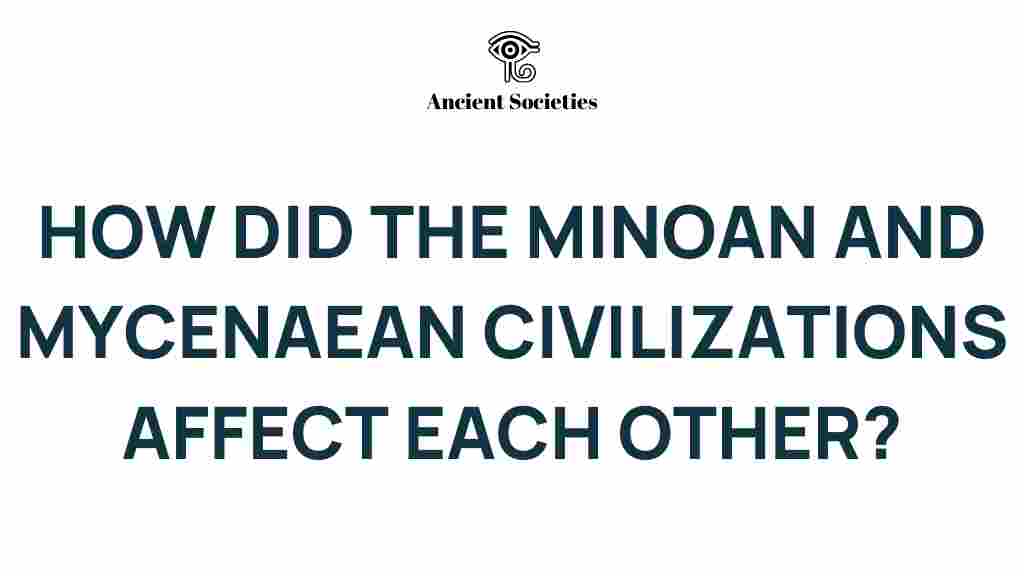Minoan Civilization and Mycenaean Civilization: An Interwoven History
The ancient civilizations of Minoans and Mycenaeans form a significant part of the tapestry of ancient Greece, showcasing a vibrant interplay of cultural exchange, trade networks, and artistic influence. This article delves into the archaeological findings and historical narratives that reveal the complexities of these two civilizations, their societies, and their lasting impact on Greek history.
Introduction to Minoan and Mycenaean Civilizations
The Minoan civilization flourished on the island of Crete from around 2700 to 1450 BCE, characterized by advanced architecture, intricate art, and a well-organized society. In contrast, the Mycenaean civilization emerged on the Greek mainland around 1600 BCE, known for its fortified palaces and warrior culture. Both civilizations played a pivotal role in the development of ancient Greece and laid the foundation for subsequent Greek culture.
This article explores how these two societies interacted, influenced each other, and contributed to the rich historical narrative of ancient Greece.
Historical Context
To understand the interplay between the Minoan civilization and the Mycenaean civilization, one must first explore their historical contexts:
- Minoan Civilization: Noted for its palatial complexes such as Knossos and its sophisticated art, the Minoans were primarily a maritime society engaged in trade across the Mediterranean.
- Mycenaean Civilization: Centered on fortified cities like Mycenae and Tiryns, the Mycenaeans were influenced by Minoan culture but developed their own distinct identity marked by a focus on military prowess and linear B script.
Cultural Exchange and Influence
The Minoan and Mycenaean civilizations were not isolated entities; rather, they engaged in a dynamic cultural exchange that shaped their societies:
Trade Networks
Trade played a crucial role in the relationships between these two civilizations. The Minoans, with their extensive maritime networks, traded goods such as:
- Pottery
- Textiles
- Metals
- Luxury items like saffron and oil
These trade routes facilitated the exchange of not only goods but also ideas, art, and technologies, which influenced Mycenaean culture significantly.
Artistic Influences
The art of the Minoan civilization, known for its vibrant frescoes and pottery, had a profound influence on Mycenaean artistic expressions. Key aspects include:
- Frescoes: Minoan frescoes depicted nature, religious rituals, and daily life, inspiring Mycenaean artistic themes.
- Pottery: The Minoans developed unique pottery styles that the Mycenaeans adopted and adapted, creating their own forms and designs.
Archaeological Insights
Archaeology has played a vital role in unraveling the connections between the Minoan and Mycenaean civilizations. Key archaeological sites include:
- Knossos: The largest Minoan palace complex, offering insights into Minoan society, economy, and art.
- Mycenae: A significant site of Mycenaean civilization, known for its impressive tombs and the Lion Gate, showcasing their architectural skills.
- Tiryns: Another Mycenaean site featuring massive walls and complex structures indicating a strong military presence.
Excavations at these sites have unearthed artifacts that demonstrate the cultural exchange between these two civilizations, including pottery, tools, and religious items.
Societal Structures
Understanding the societal structures of the Minoan and Mycenaean civilizations reveals how they influenced one another:
Minoan Society
The Minoan civilization was characterized by:
- Matriarchal Elements: Evidence suggests that women held significant roles in religious practices and possibly in governance.
- Economic Prosperity: Their economy was based on trade, agriculture, and craftsmanship, leading to a highly stratified society.
Mycenaean Society
In contrast, the Mycenaean civilization was more hierarchical, with a strong warrior elite:
- Militaristic Focus: The Mycenaeans were known for their warrior culture, evidenced by their burial practices and artifacts.
- Linear B Script: The development of this script for administrative purposes indicates a complex bureaucratic system.
Challenges in Understanding the Interplay
Despite the wealth of archaeological evidence, several challenges exist in fully understanding the interplay between Minoan and Mycenaean civilizations:
- Limited Written Records: Most of what we know comes from archaeology, as Minoan writing remains undeciphered.
- Destruction and Transition: The transition from Minoan to Mycenaean dominance involved destruction and change, complicating historical narratives.
- Cultural Appropriation: Distinguishing between Minoan and Mycenaean artifacts can be challenging due to cultural appropriation.
Conclusion: A Legacy of Interconnectedness
The relationship between the Minoan civilization and the Mycenaean civilization exemplifies the rich tapestry of ancient Greece. Through trade networks, cultural exchange, and artistic influences, these two civilizations significantly shaped each other’s development and left a lasting legacy on the history of the region.
Today, ongoing archaeological efforts continue to uncover new insights into their interconnectedness, further enriching our understanding of ancient Greece. As we explore these ancient cultures, we recognize the importance of their contributions to art, society, and the overall narrative of human civilization.
For more insights on ancient Greece, you can explore this resource on the archaeological findings of the Minoan and Mycenaean civilizations. Additionally, check out this external link for a deeper dive into the trade networks of ancient Mediterranean societies.
This article is in the category Archaeology and created by AncientSocieties Team
